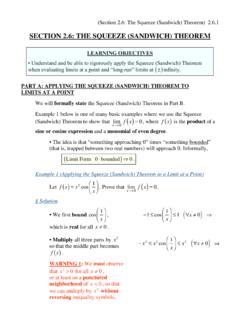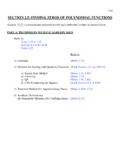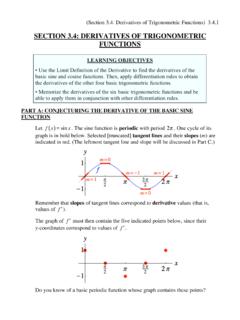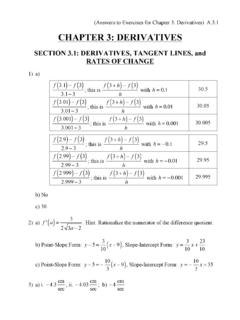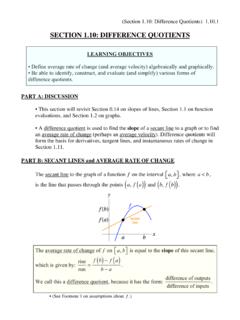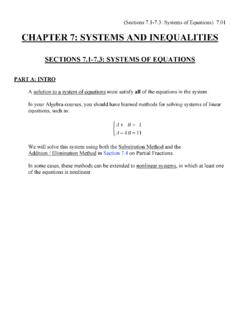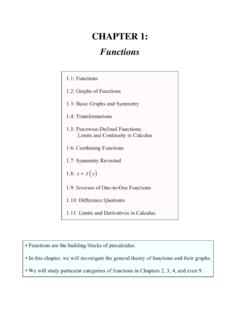Transcription of PRECALCULUS - kkuniyuk.com
1 PRECALCULUS KEN KUNIYUKI SAN DIEGO MESA COLLEGE TABLE OF CONTENTS Chapter 0: Preliminary Topics Chapter 1: Functions Chapter 2: Polynomial and Rational Functions Chapter 3: Exponential and Logarithmic Functions Chapter 4: Trigonometric Functions Chapter 5: Analytic Trigonometry Chapter 6: Topics in Trigonometry Chapter 7: Systems Chapter 8: Matrices and Determinants Chapter 9: Discrete Mathematics Chapter 10: Conic Sections, Polar Coordinates, and Plane Curves COLOR CODING Warnings are in red. Tips are in purple. Calculus comments are (sometimes) in green (clover). TECHNOLOGY USED This work was produced on Macs with Microsoft Word, MathType, Adobe Illustrator, Adobe Acrobat, and Mathematica and Calculus WIZ. CONTACT INFORMATION Ken Kuniyuki: Email address: or Website: You may download these and other course notes, exercises, and exams.
2 Feel free to send emails with suggestions, improvements, tricks, etc. LICENSING This work may be freely copied and distributed without permission under the specifications of the Creative Commons License at: PARTIAL BIBLIOGRAPHY / SOURCES Algebra: Blitzer, Lial, Tussy and Gustafson Trigonometry: Lial, Smith PRECALCULUS : Axler, Cohen, Larson, Stewart, Sullivan; REA Problem Solvers Calculus: Hamming, Larson, Stewart, Swokowski, Tan, [Peter D.] Taylor Complex Variables: Churchill and Brown, Schaum s Outlines Discrete Mathematics: Rosen Online: Britannica Online Encyclopedia: Wikipedia: Wolfram MathWorld: Other: Harper Collins Dictionary of Mathematics People: Larry Foster, Laleh Howard, Terrie Teegarden, Tom Teegarden (especially for the Frame Method for graphing trigonometric functions), and many more.
3 (Assumptions and Notation) ASSUMPTIONS and NOTATION Unless otherwise specified, we assume that: f , g, and s denote functions. (See Section ) g sometimes denotes Earth s gravitational constant. h may denote a function, or it may denote the run in some difference quotients in Sections and s often denotes a position or height function. a, b, c, k, m, and n denote real numbers. (See Section ) Let a means let a be an arbitrary real number. By arbitrary, we mean that any one will do. c sometimes denotes the speed of light in a vacuum. d sometimes denotes a distance function. e denotes a mathematical constant defined in Chapter 3. e i sometimes denotes the imaginary unit defined in Chapter 2 i= 1(). In Chapter 9, we will use i as a generic subscript (as in ai) and as an index of summation as in aii=1n ; we also use j and k for these purposes.
4 N might be restricted to be an integer n (). (See Section ) x, y, t, and typically denote variables that take on real numbers as values. z can denote a variable or a complex number (see Chapter 2). The domain of a function f , which we will denote by Domf(), is the implied (or mathematical) domain of f . (See Section ) This might not be the case in applied word problems. We assume that the domain and the range of a function only consist of real numbers, as opposed to imaginary numbers. That is, Domf() , and Rangef() . ( means is a subset of ; see Section ) Graphs extend beyond the scope of a figure as expected, unless endpoints are clearly shown. Arrowheads help to make this clearer. (See Section ) (Assumptions and Notation) MORE NOTATION Sets of Numbers (Section ) Notation Meaning Comments +, Z+ the set of positive integers This is the set (collection) 1,2,3.
5 {}. Zahlen is a related German word. is in blackboard bold typeface; it is more commonly used than Z. , Z the set of integers This set consists of the positive integers, the negative integers ( 1, 2, 3,..), and 0. , Q the set of rational numbers This set includes the integers and numbers such as 13, 94, , and comes from Quotient. , R the set of real numbers This set includes the rational numbers and irrational numbers such as 2, , e, and Think: all decimal numbers. , C the set of complex numbers This set includes the real numbers and imaginary numbers such as i and 2+3i. The Venn diagram below indicates the (proper) subset relations: . For example, every integer is a rational number, so . ( permits equality.) Each disk is contained within each larger disk. (Assumptions and Notation) Set Notation (Section ) Notation Meaning Comments in, is in This denotes set membership.
6 Example: 7 . not in, is not in Example: . such that | or : such that (in set-builder form) Example: x x>3{}, or x :x>3{}, is the set of all real numbers greater than 3. for all, for any This is called the universal quantifier. there is, there exists This is called the existential quantifier. ! there exists a unique, there is one and only one This is called the unique quantifier. Example: !x x=3, which states that there exists a unique real number equal to 3. x for every real number (denoted by x) More precisely: for any arbitrary member of the set of real numbers; this member will be denoted by x. Example: x ,x<x+1; that is, every real number is less than one added to itself. x,y for every pair of real numbers (denoted by x and y) More precise notation: x,y() 2. or {} empty set (or null set) This is the set consisting of no members.
7 Example: The solution set of the equation x=x+1 is . The symbol is not to be confused with the Greek letter phi ( ). set union Example: If fx()=cscx, then Domf()= , 1(] 1, [). is used to indicate that one or more real number(s) is/are being skipped over. Think: all members are invited. set intersection Example: 4,6[] 5,7[]=5,6[]. Think: overlap. \ or set difference, set complement Example: If fx()=1x, then Domf() is \0{}, or 0{}. We exclude 0 from . (Assumptions and Notation) Logical Operators (Sections , ) Notation Meaning Comments or, disjunction Example: If fx()=cscx, then Domf()=x x 1 x 1{}. and, conjunction Example: If fx()=x 3x 4, then Domf()=x x 3 x 4{}. or not, negation Example: The statement x=3() is equivalent to the statement x 3. implies Example: x=2 x2=4.
8 If and only if (iff) Example: x+1=3 x=2. Greek Letters The lowercase Greek letters below (especially ) often denote angle measures. Notation Name Comments alpha This is the first letter of the Greek alphabet. beta This is the second letter of the Greek alphabet. gamma This is the third letter of the Greek alphabet. theta This is frequently used to denote angle measures. or phi This is not to be confused with , which denotes the empty set (or null set). also denotes the golden ratio, 1+52, which is about Tau () is also used. The lowercase Greek letters below often denote (perhaps infinitesimally) small positive quantities in calculus, particularly when defining limits. Notation Name Comments delta This is the fourth letter of the Greek alphabet. epsilon This is the fifth letter of the Greek alphabet.
9 This is not be confused with , which denotes set membership. (Assumptions and Notation) Some other Greek letters of interest: Notation Name Comments (uppercase) delta This denotes change in or increment. Example: slope is often written as y x. It also denotes the discriminant, b2 4ac, from the Quadratic Formula. (lowercase) kappa This denotes the curvature of a curve. (lowercase) lambda This denotes an eigenvalue (in linear algebra), a Lagrange multiplier (in multivariable optimization), and a wavelength (in physics). (lowercase) pi This is a famous mathematical constant. It is the ratio of a circle s circumference to its diameter. It is irrational. (uppercase) pi This is the product operator. (lowercase) rho This denotes mass density and also the distance between a point in 3-space and the origin ( is a spherical coordinate).
10 (uppercase) sigma This is the summation operator. See Chapter 9. (lowercase) tau This denotes the golden ratio, though phi () is more commonly used. (lowercase) omega This is the last letter of the Greek alphabet. It denotes angular velocity. (uppercase) omega This denotes ohm, a unit of electrical resistance. More lowercase Greek letters: zeta (), eta (), iota (), mu (), nu (), xi (), omicron (), sigma (), upsilon (), chi (), psi () (Assumptions and Notation) Geometry Notation Meaning Comments angle See Section is parallel to See Section and Chapter 6. is perpendicular to, is orthogonal to, is normal to See Section and Chapter 6. Vector Operators Notation Meaning Comments dot product, Euclidean inner product See Chapter 6. cross product, vector product See Chapter 8.

